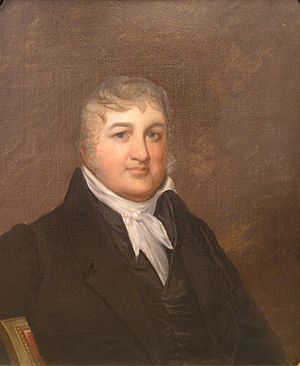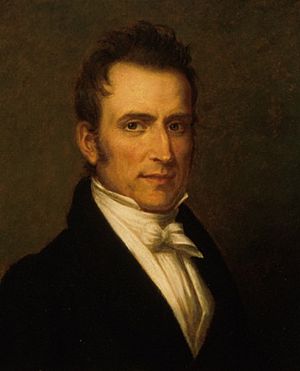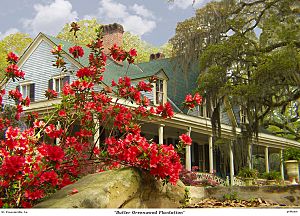George Mathews (judge) facts for kids
Quick facts for kids
George Mathews
|
|
|---|---|
 |
|
| Presiding Judge of the Louisiana Supreme Court | |
| In office 1813–1836 |
|
| Preceded by | New position |
| Succeeded by | Henry Carlton |
| Justice of the Superior Court of the Territory of Orleans | |
| In office 1806–1813 |
|
| Preceded by | Ephraim Kirby |
| Succeeded by | Court abolished |
| Justice of the Superior Court of the Territory of Mississippi | |
| In office 1804–1806 |
|
| Preceded by | New position |
| Succeeded by | Court abolished |
| Personal details | |
| Born | September 30, 1774 Augusta County, Virginia |
| Died | November 14, 1836 St. Francisville, Louisiana |
| Resting place | Grace Episcopal Church |
| Spouse | Harriet Flowers |
| Relations | George Mathews, father; Mathews family |
| Residence | Butler Greenwood Plantation |
| Alma mater | Liberty Hall Academy Washington and Lee University |
| Profession | Judge |
George Mathews Jr. (born September 30, 1774 – died November 14, 1836) was an important American judge. He served in the early days of the United States. He was a judge in the Mississippi Territory and the Territory of Orleans. Later, he became the main judge of the Louisiana Supreme Court. He held this position from 1813 until his death in 1836.
One of his most famous decisions was in the case of Marie Louise v. Marot. This ruling was later used as an example by a U.S. Supreme Court Justice. This happened during the famous 1856 Dred Scott v. Sandford case.
Contents
Early Life of George Mathews Jr.
George Mathews Jr. was born in Augusta County, Virginia. His birthday was September 30, 1774. His father, also named George Mathews, was a farmer and a soldier. He fought in the American Revolution. His father later served as the Governor of Georgia two times.
In 1785, George Mathews Sr. moved his family to Wilkes County, Georgia. This area is now called Oglethorpe County.
George Jr. went back to Virginia for his education. He studied at Liberty Hall Academy. This school later became Washington and Lee University. He first wanted to be a doctor. However, his father convinced him to study law. He learned law from his brother, John Mathews, in Augusta, Georgia.
In 1809, George Mathews Jr. married Harriet Flowers. They lived near St. Francisville, Louisiana. Their home was at her family's Butler Greenwood Plantation.
George and Harriet Mathews grew several crops. These included indigo, cotton, sugar cane, and corn. They shipped their crops from their own dock. This dock was on Bayou Sara. They also bought more land. This included a sugar plantation in Lafourche Parish. By the 1850s, they were among the top sugar planters in Louisiana.
The Mathews family owned enslaved people. These people were forced to work on their plantation. In 1826, George Mathews wrote about his enslaved workers. He said they were picking 126 pounds of cotton each day.
George Mathews Jr.'s Career as a Judge
In 1804, President Thomas Jefferson chose Mathews for an important job. He was made a judge of the Superior Court. This court was in the new Mississippi Territory. He worked there for two years.
In 1806, he became a judge for the Territory of Orleans. This territory later became the state of Louisiana.
When Louisiana became a state in 1813, new courts were created. The old territorial courts were replaced. Mathews was chosen by Governor William C.C. Claiborne. He became a judge on the new Louisiana Supreme Court. This happened on February 23, 1813. He served with other judges like Dominic Augustin Hall and Pierre Derbigny.
Mathews reportedly learned both French and Spanish. This was important because Louisiana's laws came from French and Spanish traditions. Many lawyers spoke these languages, not English.
The Dred Scott v. Sandford Connection
In the early 1830s, a family from Louisiana traveled to France. They brought their young enslaved girl, Josephine Louise, with them. When the family returned, the girl's mother went to court. She wanted her daughter to be free. She argued that being taken to France, where slavery was not allowed, made her free.
This case, Marie Louise v. Marot, happened in 1835. It went all the way to the Louisiana Supreme Court. The Court decided that if an enslaved person was taken to a place where slavery was forbidden, they became free. They could not be forced back into slavery. Mathews spoke for the court. He said that once someone was free, even for a moment, their former owner could not enslave them again.
Twenty-one years later, this decision became very important. U.S. Supreme Court Justice John McLean used Mathews' ruling. McLean was disagreeing with the main decision in the famous Dred Scott v. Sandford case.

The Dred Scott ruling said that an enslaved person was property. It said owners could take them anywhere, even places that banned slavery. The enslaved person would still be considered property. Six of the eight Supreme Court justices agreed with this. Many people consider the Dred Scott decision to be one of the worst ever made by the Supreme Court.
Legacy and Honors
George Mathews Jr. passed away in St. Francisville on November 14, 1836. He was buried at Grace Episcopal Church. He left a very large amount of money. However, his will was challenged in court. One part of his will was later canceled by the Louisiana Supreme Court.
In 1922, the Louisiana Historical Association celebrated the 100th anniversary of the Louisiana Supreme Court. They remembered Mathews as a kind and friendly person. They said he was "short, rotund, placid, even-tempered, and genial." They also praised his court opinions. They called them "fine specimens of taste and learning."
The town of Mathews, Louisiana, is named in his honor.


